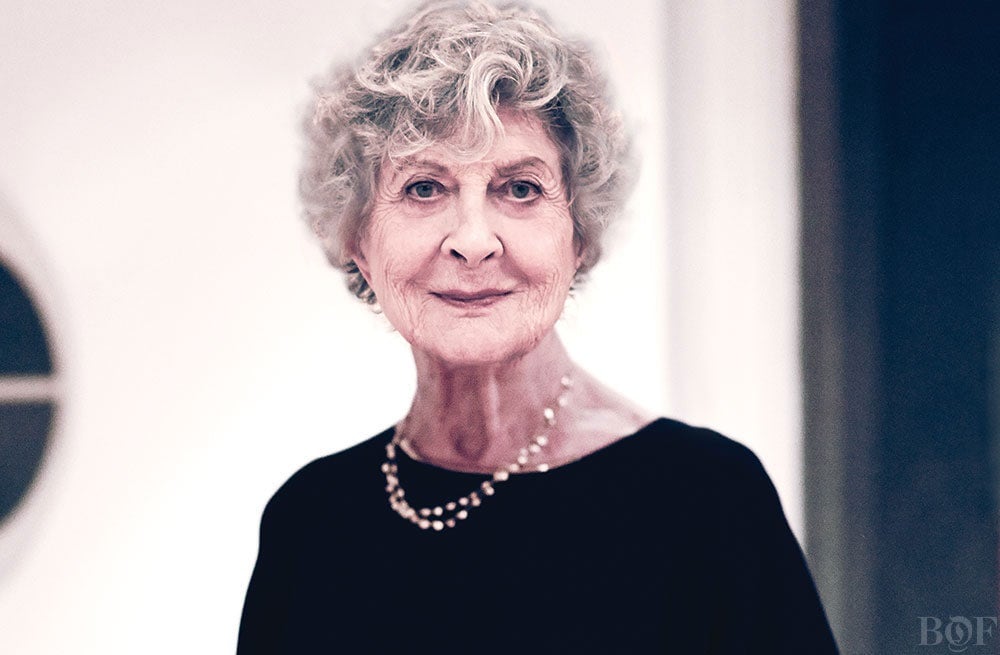
LONDON, United Kingdom — Imagine. You are sitting in the lounge of one of the world’s great hotels, waiting for a lady whom you have not met to join you for afternoon tea and, on the very dot of the appointed time, she does. No longer young but still beautiful, she is the centre of attention the minute she steps into the room, ushered in by the manager. Some wonder if she is a minor royal; others read her delicate body language and carriage as proof that she was once a prima ballerina, or even an actress. But they are wrong.
This is Joan Burstein, châtelaine of Browns, one of the most famous privately-owned fashion stores in the world, which she set up over half a century ago with her husband, Sidney, and which she still presides over, both spiritually and physically. Indeed, although she is not as involved on a daily basis as she once was, her unique taste and personality still permeate the store in London’s South Molton Street.
And today, Browns is still very much a family affair. Joan’s son Simon is the store’s chief executive, while her daughter Caroline is creative director. Both are well schooled in the Browns ethos, but Mrs B — as she is almost universally called with a mixture of awe and great affection — still stays abreast of the entire operation, monitoring sales, customers and every last detail that goes to making the shop so special. And what is special about Browns, as Joan freely admits, is that for her, to have a prosperous fashion store, it is essential to have the trust and belief of the customers. When Mrs B says she sees her loyal customers — and they are all loyal — as friends, this is not the mawkish sound bite with no substance that others in fashion retail may claim. It is the truth.
The woman who shops at Browns is looking for something special, which, in Mrs Burstein’s view, is not synonymous with flashy. “We don’t do event clothes or the ‘drop dead’ look that swamps the woman. These days, when it appears that everything has already been done, a woman must learn to create her own vision of herself and how she wants to look. When she is dressed and looking in the mirror, she must see herself, not the clothes.”
No wonder her customers trust her and she trusts them. And, of course, they are friends. How could they not be? Shopping at Browns is a life-long partnership, an ongoing lesson in good taste, by which we do not mean anything fuddy-duddy but clothes crafted with imagination and control.
This philosophy of trust and partnership extends to her staff — past and present. Even today, the ones who helped her make Browns unique are still emotionally tied to the shop and the woman. Robert Forrest, who came to her in 1972, at the age of 23, is a good example. He and Mrs Burstein still have a relationship built on mutual trust and belief in each other’s abilities. I remember being with Robert in Brazil a few years ago, when he had started his freelance career. And encountering a jewellery designer who was doing marvellously bold designs, Robert immediately said, “I’m going to phone the Mrs (as the shop staff often called Mrs Burstein). She will love this.” He did. I heard him describing the jewellery and when he came off the phone, he made a sizeable order on Browns’ behalf. Robert knew his former boss’ taste and Joan trusted his eye sufficiently to agree to the deal without even seeing the jewellery.
It says everything about Joan Burstein as a mentor, guide and friend to her staff. Indeed, she once told me that she does not always warm to everything that is bought for the various Browns boutiques by some of her young buyers, but she knows that retail can never stand still and is delighted when their viewpoint is vindicated by sales figures. She is also happy when they move on to new things: Richard James, Marion Hume, Yasmin Sewell and Mandi Lennard are just a few of the many former staffers who have benefitted from their time at Browns, just as at Feathers, Mrs Burstein’s earlier store, where Manolo Blahnik learned the ropes while selling jeans.
Sarah Harrison, who was with Browns even before Forrest and went on to run Ralph Lauren‘s affairs in London, recalls the early days when the Missoni consignments arrived at the shop: “The Mrs was down on the floor with us girls, as excited as a child on Christmas morning, selling the clothes before they had even been booked in. She loved making a sale and was always ready to help us to do the same, even to getting down on her hands and knees and pinning a skirt hem for a client to convince her that the look was right for her. We all loved her. She was our surrogate mother and her remedy for any problem — a hangover, stomachache or love trouble — was always the same: ‘Eat a finely grated apple, dear, and you’ll feel so much better!’ We were encouraged to have our own customers and mine included Anna Wintour, Linda McCartney and Margot Fonteyn.”
But, over the years, Burstein’s influence on fashion has reached much further than South Molton Street. She was literally an oracle. At the collections, people would ask: “Has Mrs B been in yet?” or, if she had, “Did Mrs B start to write?” (the code for placing an order). Her knack for grasping the zeitgeist and pioneering new labels was such that major stores in London and New York hung on until they were sure Mrs Burstein had indicated her interest in a designer before buying into a collection with more certainty than they would otherwise dare, knowing that they could trust her taste better than their own.
They could do so because of Joan Burstein’s passionate love of fashion and her desire to share her knowledge with all — once she had the label in question under contract. Indeed, she was also, in the most elegant, lady-like manner, a most determined fighter for what she wanted and, it would seem, always got it, no matter how tough her terms.
Mrs B also had terrific attention to detail. Every Monday afternoon, she would manually go through all the sales of the previous week with the buying team, which consisted of her, Robert Forrest, Francoise Tessier, and Andrea von Tiefenbach. As Robert Forrest says, “Joan monitored every sale and was always very decisive in her buying. She always had a set budget in her head but if she wanted a certain label and knew that she could sell it, she was prepared to exceed that amount and buy more heavily. And she never really made a mistake. She always phoned Sidney to check on the financial situation, but he always said that if she felt it really was right he would trust and support her judgement.”
Fashions changed, but Mrs B’s antennae remained highly tuned to new designers, even when she has felt they were not right for her customers. But the boldness of her instincts never let her down. She understood John Galliano from his graduate collection — and she bought it all, putting it in the windows at South Molton Street. Most retailers had dismissed it as unsellable fantasy but she proved them wrong. At Browns, Galliano’s work was not just a one-off novelty, as it might have been in other hands. She made it saleable by showing the collection’s beauty and subtlety of cut to her clients — clients who kept coming back for more, as they did with Alexander McQueen, Hussein Chalayan and Meadham Kirchhoff.
As Manolo Blahnik put it to me, “Joan embodies the talent of how to buy and how to foresee what is going to come. She has this gift. Always has and always will. I have an incredible respect for her. She is a supremely elegant person.”
As Mrs B herself says, “I could never do the ordinary.”


